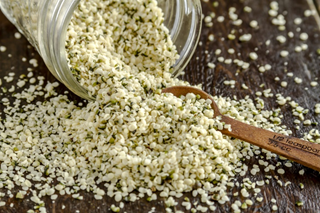Marijuana has shown its usefulness in medical applications for decades, and still more ways to use marijuana as a medical treatment are discovered every few months. THC is a powerful cannabinoid that overwhelms the body, interrupting negative messages and facilitating various healing processes, like reducing inflammation, relaxing muscles and stimulating digestion.
Yet, psychoactive THC isn’t the beneficial element of marijuana. In fact, hemp, which is the non-psychoactive variant of the cannabis plant, offers perhaps dozens of benefits to many people within the medical field, from patients to healthcare providers. Here are a few major ways hemp can be useful to medicine.
CBD
Cannabidiol, or CBD, is the second-most prevalent cannabinoid in cannabis plants. Unlike THC, CBD doesn’t have any psychoactive effects, and thus, when users take CBD, they don’t experience any sort of high. However, as a cannabinoid, CBD does interact with the body’s natural endocannabinoid system, which facilitates messages between the brain and body. As a result, CBD has a noticeable effect on a user’s health, which has already been exceedingly beneficial in medicine.
As yet, researchers aren’t entirely certain how CBD works within the endocannabinoid system, but they are certain that it does work. Currently, there is an FDA-approved CBD-based medicine on the market, available to sufferers of a particularly pernicious form of childhood epilepsy. Other initial research on CBD indicates that CBD could be an effective tool for managing clinical mental disorders like anxiety, depression and even schizophrenia as well as inflammatory and neuropathic pain, such as that caused by arthritis or nerve damage. What’s more, research is yet to find any sort of danger from CBD, meaning users should be able to take it without fear of overdose or lasting harm.
More study is imperative to identify exactly how CBD is functioning in the human body, but it is an exceedingly promising hemp-based tool for medicine in the coming years. Users can read more about the ongoing discoveries associated with CBD here: health.harvard.edu.
Nutrition
Cannabis has been reviled as a dangerous drug for so long that many have forgotten the plant’s origins: as a valuable source of nutrition. When a cannabis plant’s flowers are fertilized, they grow seeds, which contain vital macro- and micronutrients often lacking in modern diets. Because dietary deficiencies are a significant cause of health concerns, even in civilized countries, supplementing hemp seeds could be a useful solution to many nutrition-based ills.

Sometimes called hemp hearts, hemp seeds have an astonishing 9.5 grams of complete protein in just three tablespoons, making them an ideal source of protein for vegetarians, vegans or anyone else at risk of protein deficiency. Additionally, hemp hearts are a good source of healthy omega-3 fats as well as vitamins and minerals such as iron, zinc, folate, thiamine and magnesium.
Though marijuana leaves and stems contain a high concentration of psychoactive THC, the same parts of hemp plants contain a minute fraction of that cannabinoid — and hemp seeds contain essentially none. Thus, consuming hemp seeds will not get a person high or cause them to fail a drug test. Anyone who is concerned about the relation of hemp seeds to marijuana can read more about the similarities and differences in cannabis plants here: weedmaps.com.
Hemp Fiber Products
Another historical use of hemp was as a fiber. For centuries, hemp was the main source of fiber used in textiles like clothing, ropes and ships’ sails because cannabis plants grow quickly, densely and without much fuss and produce fibers that are lightweight, strong, durable and resistant to water, mold, insects and other potential hazards.
The healthcare industry could make abundant use of hemp fibers, replacing many relatively unsustainable materials with hemp to cut costs, reduce waste and provide alternative options to providers and patients. Some examples of hemp products useful to medicine include:
- Swabs. Cotton swabs are fine, but if the COVID pandemic has demonstrated anything, it is that more options of greater availability of basic medical supplies is absolutely warranted. Some people prefer the feel of so-called H-tips, or hemp-tipped swabs, but mostly they are more economical for clinics and hospitals.
- Bandages. Modern bandages are primarily made of synthetic latex and woven plastic fabric, which both fail to adhere well to human skin and fail to biodegrade in landfills. Hemp bandages offer a more comfortable and sustainable solution, and they do not irritate the skin like unnatural materials often do.
- Textiles. Hemp fibers perform best when woven into a textile, which can then produce hospital scrubs, linens, masks and other health care essentials. Again, hemp fibers are a natural and eco-friendly material that could quickly and safely replace the synthetic options currently in use.
Of course, there are many more applications of hemp fiber throughout the healthcare industry and beyond. Those interested can read more about the uses for hemp fiber here: hempfoundation.net.
Non-psychoactive hemp is just as valuable to medicine as THC-heavy strains of marijuana. In the coming years, health care providers should begin to invest heavily in hemp — and everyone will reap the benefits.
Disclaimer: This article is intended for information and entertainment purposes only and is not intended to reflect the specific views of the publication.






